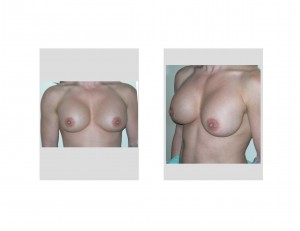Breast augmentation is not an uncommon request amongst women who are enthusiasts for bodybuilding and fitness activities. This extreme fitness activity can cause loss of any residual breast tissue as muscle mass is increased and body fat is lost. This is particularly relevant for those women who didn’t have much breast tissue naturally. When combined with a more pronounced pectoralis muscle outline and profile, the appearance of a defined breast can be completely lost or largely obscured.
Female bodybuilders have understandable concerns about breast augmentation since it is surgery on the pectoralis muscle. Common questions include where should the implant be placed, how soon can one return to working out, and will it ultimately affect muscle strength and development.

The one aesthetic consideration in a body builder about an implant placed under the muscle is the bouncing of the implant or flattening of the breast mound when the pectoralis muscle is flexed. While this perfectly normal and causes no harm to the implant, it may be a visual issue in competitive events or just simply cosmetically disturbing.
One thing to realize is that a breast implant placed under the muscle…isn’t completely under the muscle. A proper implant position is largely centered under the nipple. That makes half of the implant under the pectoralis muscle, but the lower half is not covered by the muscle. Keeping a breast implant completely under the pectoralis muscle would place the new breast mound (implant) too high on the chest wall.
Regardless of the position of the implant, there must be an incision somewhere to get it there. Generally, I use an incision in the inframammary fold under the breast for silicone implants and an armpit (axillary) incision for saline implants. In a bodybuilder, however, I have concerns about an armpit scar. Because of their frequent wear of sleeveless clothing, a scar in the armpit may be seen. While an armpit scar is small and heals quite well, this is always a concern in the bodybuilding patient.
Breast augmentation patients may return to cardio in one week after surgery and they can start lifting with light weights after two weeks. Chest exercises with heavy weights should be avoided for the first month. This will give the pectoralis muscle plenty of time to heal. In the first days to week after surgery, arm range of motion exercises (without weights) should be aggressively done. This will help one get back to normal faster and lessen the amount of discomfort that occurs. I have had a few bodybuilding patients tell me they were back to bench pressing in two weeks, and although I would not endorse it, does not surprise me given the conditioning of the pectoralis muscle they had before surgery. In addition, while a few of the lower attachments of the muscle to the sternum have been released, the insertion of the muscle is left largely undisturbed. This would also account for why there is no evidence that the ability to grow the muscle and increase its size and power is unaffected by submuscular breast implant surgery.
Dr. Barry Eppley
Indianapolis, Indiana


